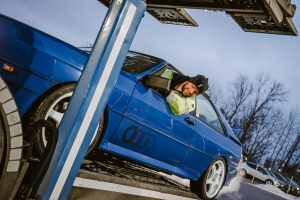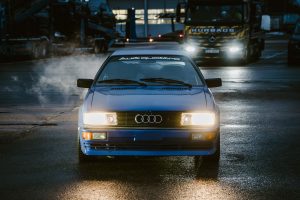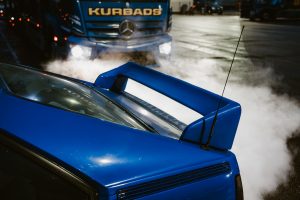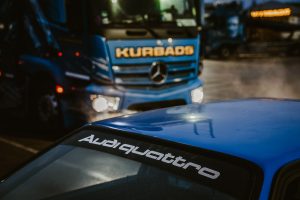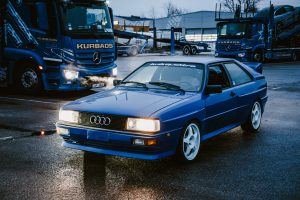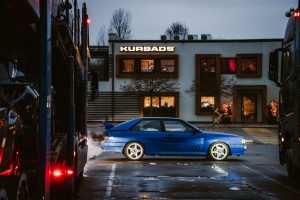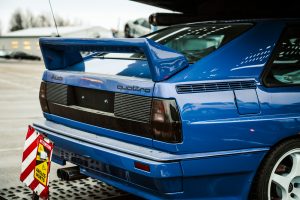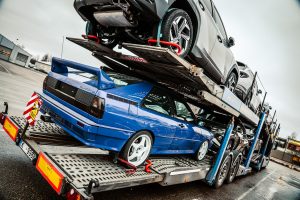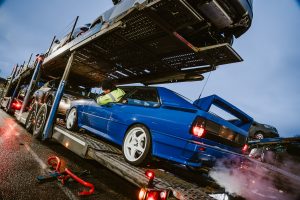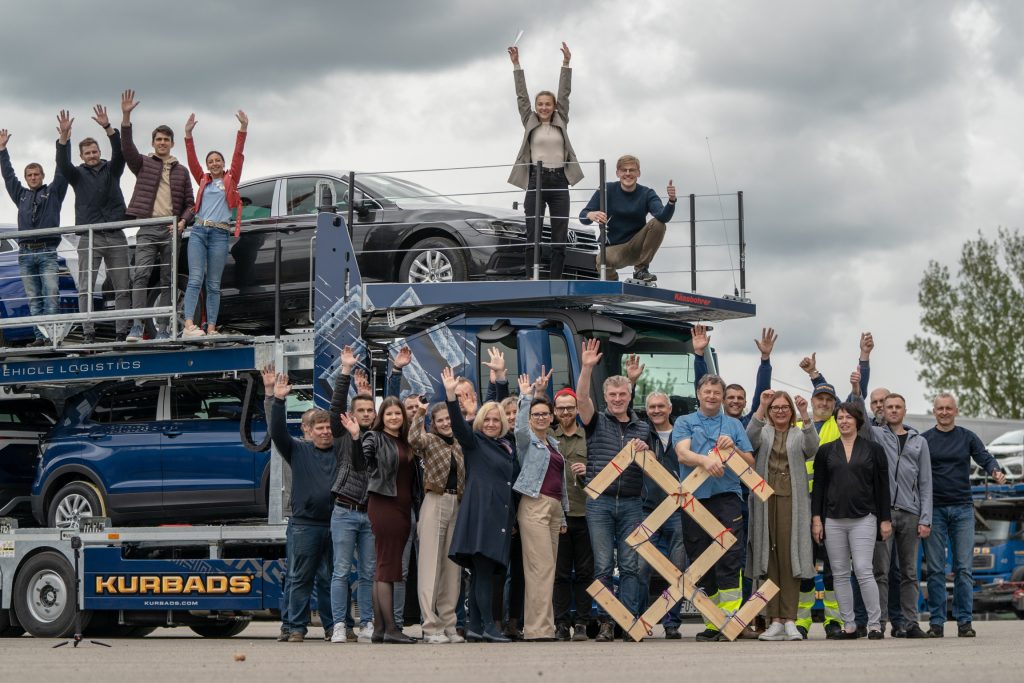The encounter between a strikingly blue 1985 Audi Quattro and the equally vibrant blue Kurbads vehicle carriers is a fantastic opportunity to revisit and savor the iconic pages of all-wheel-drive history. The Audi Quattro became the first series production model from Ingolstadt with permanent all-wheel drive, which over time earned it the extended name Ur-Quattro. The peculiar German prefix “Ur-“, highlighting the object’s original origin and honor, contributed to the establishment of the playful nickname “urka” in the Latvian language. The true and only Audi Quattro is a boxy two-door coupe with a longitudinally mounted five-cylinder turbo engine, manual transmission, lockable differentials, and a rather austere interior. It was produced from 1980 to 1991, meaning the last Ur-Quattro models “outlived” the new Audi Coupe by two years, which in 1988 was based on the widely known Audi 80 “bubble”. The technological sensation of the Audi Quattro took such deep roots that the model lasted eleven years without significant external changes, except for the original four headlights being replaced by one-piece light units in 1983, and minor improvements such as a painted composite spoiler instead of the original rubber “blade”. The Ur-Quattro was last modernized in 1985, by which time nearly ten years had passed since the idea of an all-wheel-drive Audi.
🍀 A Bright Idea in Lapland’s Darkness
In January 1977, Audi’s chassis development leader Jörg Bensinger returned from winter tests in Rovaniemi, Northern Finland, literally glowing. The cause of the engineer’s excitement was not a meeting with Santa Claus but a ride beyond the Arctic Circle in the primitive Volkswagen off-road vehicle Iltis. Bensinger noticed that the nimble 75 horsepower vehicles accelerated much more convincingly on compacted snow than his significantly more powerful two-wheel-drive car. How great it would be to equip not just a simple rural all-terrain vehicle but also a proper passenger car with all driving wheels! Back in Ingolstadt, Jörg quickly enchanted Audi’s pre-development department head, Walter Treser, with his idea. Inspired, they both went to Audi’s head of technological development, the then not yet legendary Ferdinand Piëch. The future mega-industrialist immediately appreciated the all-wheel-drive concept, and why not: his grandfather Ferdinand Porsche had already worked on the all-wheel-drive concept for military tractors for the Austrian army and later for Cisitalia racing cars. But how to convince Volkswagen group’s management of the idea’s viability and, importantly, profitability? Since the consolidation of the four former Auto Union brands under the Audi name and their inclusion in the Volkswagen group in 1964, the four rings had failed to find their niche in the car market, let alone dream of competing with BMW and Mercedes-Benz.
🚙 What’s at Hand
The only solution was to convince the senior management with a running prototype. Work on the Quattro (which wasn’t yet a Quattro) began in February 1977, and by November of the same year, the test car was ready. The A1 or “Allrad Nummer 1” was built using the B1 generation Audi 80 as a base and the all-wheel-drive technology from the same VW Iltis, making it possible to create the prototype so quickly. Technically, it wasn’t very sophisticated, as the drive shaft necessary for rear-wheel drive was directly bolted to the transmission’s output shaft. Fortunately, there was enough room for all of this, including the five-cylinder turbo engine developed by motor engineer Franz Hauk, within the modest Audi 80 body. Treser later admitted that at that point, the engineering group still dared not dream beyond a race car prototype that could be produced in limited numbers for homologation purposes, similar to the Ford RS200 or the like. However, the A1 soon demonstrated significantly higher potential.
👻 Phantom of the Opera
In January 1978, Volkswagen marketing chiefs Dr. Werner P. Schmidt and Edgar von Schenk met in the Turrahn highlands in the Austrian Alps – officially for winter tire testing. There, without prior notice, they were introduced to the A1 prototype in action. Taking a considerable risk, the project’s authors chose a particularly steep section of the highland – a private road from the Turrahn valley to Rosantine. Special permission was needed to use it, and until then, only off-road vehicles could conquer this path, especially not in winter, because in places, the gradient reached up to 23%! The Quattro prototype managed it even without winter tires. The marketing team left Austria utterly dazzled by the car’s capabilities, but it was too early to celebrate – they still needed to win over Volkswagen’s board of directors. And here, the development group simply got lucky. Volkswagen’s R&D head, Professor Ernst Fiala, agreed to test the car himself and took it for a weekend trip to his native Vienna. Since it was May, there was no chance to show off in the snow, but something else happened. Fiala allowed his esteemed wife to navigate the prototype into an opera house parking spot – quite a feat, considering the all-wheel-drive transmission was connected “solidly.” Yet, Fiala remained skeptical about the idea of an all-wheel-drive car, and upon returning to Germany, he handed back the prototype with a brief note: “It needs a central differential.” The Iltis didn’t have one due to its direct application, as all-wheel drive was mechanically engaged with a lever.
🌟 Shaft within a Shaft
Then came the moment for transmission specialist Hans Nedvidek. A differential from the Audi 80 was implanted directly behind the gearbox, and the drive to the front wheels was executed through a hollow shaft, which in turn was bolted onto the newly introduced differential at the other end. This simple yet ingenious solution with interlocking shafts still elicits a chuckle today, just as it did for the Lancia rally team mechanics in the film “Race for Glory: Audi vs. Lancia” when they dismantled a street Audi Quattro in their workshop. Among other things, the lack of space and compositional challenges long deterred Audi’s current competitors, BMW and Mercedes-Benz, from wider application of all-wheel drive in the 90s, making it rare in standard body types and often limited to a single engine. Thus, the first-generation Quattro transmission was born, featuring an open differential, a 50:50 torque distribution between axles, and manual locking for the central and rear differentials. Initially, locking was achieved with a lever pulled between the seats, until in 1981 Audi introduced a switch that activated a pneumatic actuator. Since the Audi Quattro was in production long enough to witness the next generation of Quattro with a Torsen type self-locking differential, by 1987, the need for manual locking and the corresponding button in the cabin naturally disappeared.
🚒 Firefighters’ Trick
However, one more green light was needed for Quattro’s launch, and only Volkswagenwerk AG’s CEO Toni Schmücker could give it. Lengthy excursions to the Alps were not an option, so the decisive demonstration was chosen on a sufficiently steep hill in Gaimersheim, near Ingolstadt. To be absolutely sure, the project’s mastermind Piëch resorted to a trick and had the factory’s firefighting brigade douse the hill’s meadow thoroughly. When Schmücker arrived, there were no visible signs of the diversion, but the result was convincing – no matter how grandly the director tried to tackle the slope, single-axle cars invariably got stuck. When it was the prototype’s turn (by then it was called A2, as it was clad in the latest Audi 80 body), the boss might have been slightly deflated, for he attacked the meadows with such gusto that the entire development department held their breath. But everything went smoothly, and the goal was achieved – there was no longer any talk of mere race car prototypes, the Audi Quattro could now only be a mass-produced vehicle. In January 1979, now as the A3 prototype with a body designed by Hartmut Warkuß for a two-door coupe, the Quattro, along with the previous prototypes, once again headed to Lapland – this time for final tests.
🏅 Launch in Geneva
The rest, as they say, is the well-known history of the Audi Quattro. This unusually robust coupe made its debut at the Geneva Motor Show in 1980, and the first units were delivered to select Audi dealers in December of the same year. One had to be a true technology enthusiast to pay 49,900 German marks for an Audi, the same price as a Porsche 911 SC. The coupe’s flamboyant appearance was enhanced by widened wheel arches, designed by British-born designer Martin Smith. The interior of the all-wheel-drive marvel was quite spartan – modest “gauges” from the Audi 80 (later replaced by liquid crystal displays), distinctive seat, door, and ceiling linings, and a steering wheel, gear shift lever, and its boot covered in leather. And two bulbs with all-wheel-drive symbols right below the radio – locking signal lights. Yet, there was no less space in the back than in the 30 centimeters longer 6 series BMW and Mercedes SLC. Practical considerations and market interests soon prompted Audi to release a simplified Coupe model with front-wheel drive and Giugiaro design, produced in a fifteen times larger series than the Quattro (174,687 against 11,452). In 1981, Audi launched its rally program, which resulted in B group rally monsters with 600 horsepower, A1, A2, and S1 race cars, as well as the collector’s favorite 306 HP street car Audi Sport Quattro, priced at 203,000 German marks, and known for its shortened wheelbase as the “short urka.” Although the turbo engine’s power had grown from the original 160 horsepower to 200, the fiery Quattro was not terrifying – 7.4 seconds to reach 100 km/h. Acceleration and especially maximum speed were hampered by aerodynamic drag, which reached 0.4 Cw units compared to competitors’ 0.36 or even less. Moreover, the machine turned out to be quite thirsty – 16.6 liters in the first Auto Motor und Sport test, while Audi promised 7.9 – 10.4 liters on the highway or 15.7 liters in the city. The insatiable appetite of the Audi Quattro largely determined its greater weight compared to the Audi Coupe. Only 75 of the 250 kilograms were due to the all-wheel drive, the rest went to the larger engine, tires, extras, and, most importantly, a 91-liter fuel tank. Over eleven years, the Audi Quattro had three engine generations, with the last having a 2.2-liter capacity, two camshafts in place of one, and four valves per cylinder. However, the most significant turn in the development of Audi Quattro engines came in 1979 when Audi was joined by Fritz Indra. Before Audi, he worked at Alpina (a BMW tuning company), where he encountered turbocharging and exotic injection systems. Having examined the original 2.1-liter “five-cylinder,” Indra announced that it needed an electronic ignition system. Soon it became clear that he was right. With a more modern control system, the engine ran smoother, more powerful, and virtually without a “turbo lag.” But where to get enough electronic ignition systems in such a short time before the premiere? The domestic supplier Bosch was outpaced by the Japanese, as only Hitachi could produce and deliver the necessary electronics on time. The Japanese system turned out to be a real find, as it could recalculate the ignition point according to 250 different parameters, and Audi’s development department could finally proudly announce: “At last we have our own Porsche!”
Did You Know:
➡️ When the Volkswagen group’s board of directors approved the Quattro project, it wanted to rename the all-wheel-drive system to Carat and equip its brand’s cars with it. Industrial legend has it that being called Audi Carat, and the car’s escape from this unenviable fate, was due to a potential copyright lawsuit with a cologne of the same name manufacturer, but Quattro’s inseparable marriage with the Audi brand was ensured by F. Piëch’s managerial talent;
➡️ Volkswagen did get quattro for a while. An analogous system to that of the Audi models was installed in the 90s on the B5 generation Passat and the luxury sedan Phaeton, as they had longitudinally mounted engines. However, the quattro sub-brand on VW cars was nevertheless replaced by 4Motion;
➡️ Official legend states that the Audi Quattro was derived from the Volkswagen Iltis, but in fact, it was somewhat developed from Audi. As early as 1956, Auto-Union in Ingolstadt began producing a versatile all-purpose all-wheel-drive off-road vehicle, DKW Munga, which bore the four-ring symbol on its front. The vehicle proved so successful and in demand by various countries’ armies that Volkswagen management decided to “adopt” the model and sold it in a modernized form as the VW Iltis. Thus, it could be argued that Audi’s first victory in the Dakar Rally was not in that year but already in 1980, when the Iltis won in Africa – all the more so because the Iltis’s all-wheel-drive system was created using components from the then-current Audi 100;
➡️ Before the charming Michèle Mouton with the Audi Quattro in 1981 became the first woman to win a World Championship rally, seven out of ten French people surveyed believed Audi was a washing machine manufacturer;
➡️ A test drive with the Sport Quattro once left such an indelible impression on the Sultan of Oman that he ordered 16 such cars for a family celebration. Since only 8 or 10 of the two hundred cars required for rally homologation remained in the factory, the Audi importer’s representative literally traveled around Germany with a suitcase full of money to buy back the missing cars from their owners;
➡️ The last Audi Sport Quattro was given by Ferdinand Piëch to his wife, Louise;
➡️ Although legendary rally driver Walter Röhrl once said that “with the Audi Quattro, even a trained monkey could win,” he himself only managed it twice.








